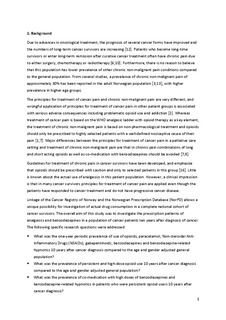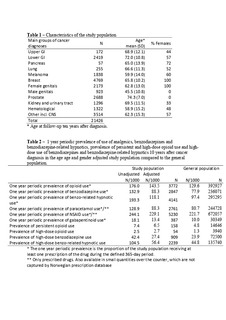| dc.contributor.author | Fredheim, Olav Magnus | |
| dc.contributor.author | Skurtveit, Svetlana | |
| dc.contributor.author | Handal, Marte | |
| dc.contributor.author | Hjellvik, Vidar | |
| dc.date.accessioned | 2020-02-18T06:25:19Z | |
| dc.date.available | 2020-02-18T06:25:19Z | |
| dc.date.created | 2019-04-08T16:33:57Z | |
| dc.date.issued | 2019 | |
| dc.identifier.citation | Pain. 2019, 160 (4), 852-859. | nb_NO |
| dc.identifier.issn | 0304-3959 | |
| dc.identifier.uri | http://hdl.handle.net/11250/2642101 | |
| dc.description.abstract | Chronic pain due to surgery, radiotherapy, or chemotherapy is prevalent in long-term cancer survivors. Chronic pain due to successful cancer treatment should be treated as chronic nonmalignant pain, primarily with nonpharmacological strategies. Based on complete national data from the Cancer Registry of Norway and the Norwegian prescription database, the aim of this study was to compare the use of nonopioid analgesics, opioids, and benzodiazepines 10 years after cancer diagnosis in long-term cancer survivors and the age- and sex-adjusted general population. The 1-year periodic prevalence of use was higher in long-term cancer survivors in all the studied drug classes: opioids (143.5 vs 129.6/1000), paracetamol (88.3 vs 80.7/1000), nonsteroidal anti-inflammatory drugs (229.1 vs 221.7), gabapentinoids (13.4 vs 10.0/1000), benzodiazepines (88.3 vs 77.9/1000), and benzodiazepine-like hypnotics (118.1 vs 97.4/1000). The prevalence of persistent and high-dose opioid use (>365 defined daily doses [DDDs] and >730 DDDs, respectively, during 365 days, and prescriptions all quarters of the year) was also higher in the cancer survivors than in the general population (6.5 vs 4.8/1000 for persistent use and 2.7 vs 1.3/1000 for high-dose use). Less than 10% of persistent and high-dose users received only long-acting opioid formulations. Furthermore, most long-term cancer survivors with persistent or high-dose opioid use were also high-dose users (>100 DDDs/year) of either benzodiazepines or benzodiazepine-like hypnotics. It is an issue of concern that most of those using opioids did not adhere to guidelines regarding opioid formulation and comedication with other drugs with addictive properties. | nb_NO |
| dc.language.iso | eng | nb_NO |
| dc.publisher | Lippincott, Williams & Wilkins | nb_NO |
| dc.title | A complete national cohort study of prescriptions of analgesics and benzodiazepines to cancer survivors in Norway 10 years after diagnosis | nb_NO |
| dc.type | Journal article | nb_NO |
| dc.type | Peer reviewed | nb_NO |
| dc.description.version | acceptedVersion | nb_NO |
| dc.source.pagenumber | 852-859 | nb_NO |
| dc.source.volume | 160 | nb_NO |
| dc.source.journal | Pain | nb_NO |
| dc.source.issue | 4 | nb_NO |
| dc.identifier.doi | 10.1097/j.pain.0000000000001459 | |
| dc.identifier.cristin | 1690935 | |
| dc.description.localcode | © 2019. This is the authors' accepted and refereed manuscript to the chapter. Locked until 30.4.2020 due to copyright restrictions. The final authenticated version is available online at: http://dx.doi.org/10.1097/j.pain.0000000000001459 | nb_NO |
| cristin.unitcode | 194,65,25,0 | |
| cristin.unitcode | 1920,28,1,0 | |
| cristin.unitname | Institutt for sirkulasjon og bildediagnostikk | |
| cristin.unitname | Nasjonal kompetansetjeneste for pasienter med sammensatte lidelser | |
| cristin.ispublished | true | |
| cristin.fulltext | postprint | |
| cristin.qualitycode | 2 | |

